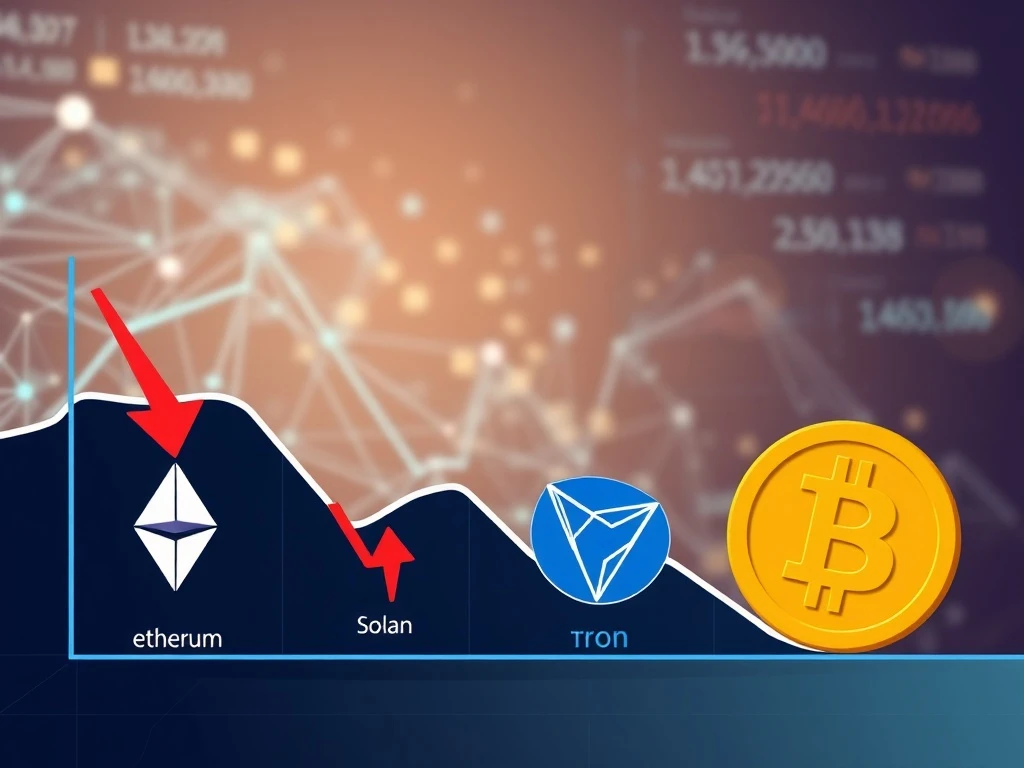Crucial VanEck Report: Blockchain Network Revenue Plunges 16% in September

Blockchain network revenue experienced a significant downturn in September, falling by 16% month-over-month. This decline signals a shift in the crypto ecosystem. Asset manager VanEck detailed these findings in a recent report. The firm attributed the broad reduction to lower volatility across crypto markets. This trend affects key players and the overall health of the digital asset space.
Unpacking the VanEck Report on Blockchain Network Revenue
A comprehensive VanEck report highlighted a substantial decrease in economic activity within the blockchain ecosystem during September. Specifically, network revenues across various platforms saw a 16% reduction. This widespread decline suggests a broader market trend. Analysts often monitor these figures closely. They provide crucial insights into the underlying health of decentralized networks. The report underscored a primary cause for this contraction: diminished crypto market volatility. This factor directly influences trading behavior and fee generation.
Impact of Crypto Market Volatility on Network Fees
Reduced volatility directly impacts network fees. When prices remain stable, fewer arbitrage opportunities emerge. Traders consequently pay lower priority fees. This pattern was evident across major cryptocurrencies. Ether (ETH) volatility dropped by 40% in September. Solana (SOL) volatility also fell by 16%. Bitcoin (BTC) volatility decreased by 26%. These figures illustrate a widespread market calm. The VanEck report explained this relationship clearly. Fewer speculative trades mean less demand for rapid transaction processing. This directly translates to lower revenue for networks.
Diving Deeper into Ethereum Fees and Other Network Declines
Several prominent blockchain networks felt the revenue pinch. Ethereum fees, for instance, saw a 6% reduction. This marks a notable decrease for the leading smart contract platform. Solana’s network revenue also dropped by 11%. However, the Tron network experienced the most significant reduction. Its fees fell by a striking 37%. This substantial decline on Tron had a specific reason. A governance proposal implemented in August reduced gas fees by over 50%. This intentional change dramatically lowered transaction costs. Therefore, it directly impacted revenue generation for the network. The VanEck report carefully separated these distinct causes. It differentiated between market-driven declines and policy-driven changes.
Tron’s Unique Position Amidst Fee Adjustments
Tron’s sharp revenue drop stemmed from a strategic decision. A governance vote successfully lowered gas fees. This move aimed to enhance network accessibility. It also sought to attract more users. While beneficial for users, it impacted revenue metrics. The network intentionally traded immediate revenue for broader adoption. This contrasts with declines seen on other networks. For Ethereum and Solana, market conditions primarily drove fee reductions. Tron’s situation offers a unique case study. It highlights how internal policies can significantly shape network economics. The VanEck report provides this crucial context.
Tron Stablecoin Dominance and Revenue Resilience
Despite its recent fee reduction, the Tron network maintains a powerful revenue position. It ranks as the number one crypto ecosystem for revenue. Data from Token Terminal confirms this leadership. Tron generated an impressive $3.6 billion in the last year. By comparison, Ethereum generated only $1 billion over the same period. This occurred even as ETH hit all-time highs in August. Ethereum also boasts a much larger market capitalization. Its $539 billion valuation dwarfs Tron’s $32 billion. Tron’s revenue strength largely comes from its Tron stablecoin ecosystem. It plays a critical role in stablecoin settlements. This is a key differentiator for the network.
The Growing Influence of Stablecoins on Blockchain Activity
Stablecoins are fundamental to Tron’s success. 51% of all circulating Tether USDt (USDT) supply resides on the Tron network. This massive integration fuels network activity. The stablecoin market cap continues to expand. It crossed $292 billion in October 2025. This growth has been steady since 2023, according to RWA.XYZ data. Stablecoins represent a major use case for blockchain technology. Governments also explore placing fiat currencies on crypto rails. These rails offer numerous advantages. They allow near-instant settlement times. Fees remain minimal. Trading occurs 24/7. Access does not require traditional banking infrastructure. The Tron stablecoin ecosystem leverages these benefits effectively. It provides efficient cross-border transactions.
The Broader Implications of Declining Blockchain Network Revenue
Network revenues and fees serve as vital indicators. They reflect economic activity within crypto ecosystems. Market analysts, traders, and investors rely on these metrics. They gauge the overall health of specific ecosystems. They also assess individual projects. Furthermore, they provide insights into the broader crypto sector. A decline in blockchain network revenue can signal several things. It might suggest reduced user engagement. It could also point to lower demand for network services. Alternatively, it might reflect a shift in market sentiment. Understanding these revenue trends is essential. It informs investment decisions. It also helps project developers strategize for growth. The VanEck report offers a timely snapshot. It shows how external market forces impact these critical financial flows.
September’s 16% drop in blockchain network revenue underscores market sensitivity. Reduced crypto market volatility played a significant role. It impacted networks like Ethereum and Solana. However, Tron’s unique governance decision also shaped its revenue figures. Its strong position, driven by Tron stablecoin settlements, remains noteworthy. The VanEck report provides valuable data for understanding these dynamics. As the crypto market evolves, monitoring these fundamental metrics will remain crucial. Investors and developers must adapt to changing market conditions. They must also consider internal network policies. These factors together shape the future of decentralized finance.







